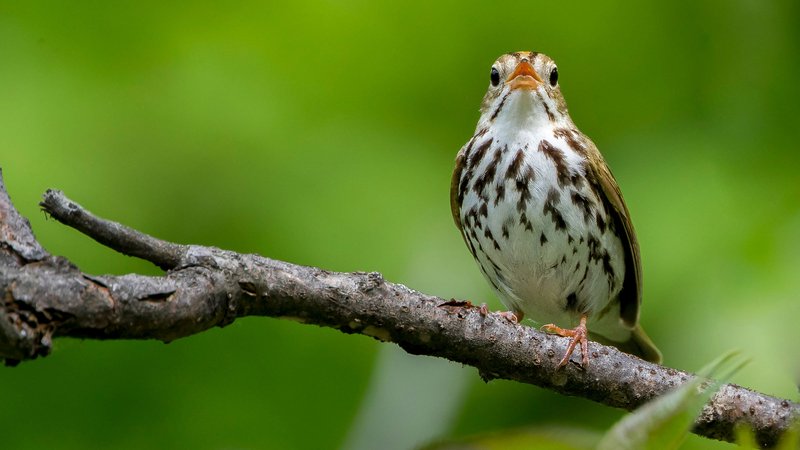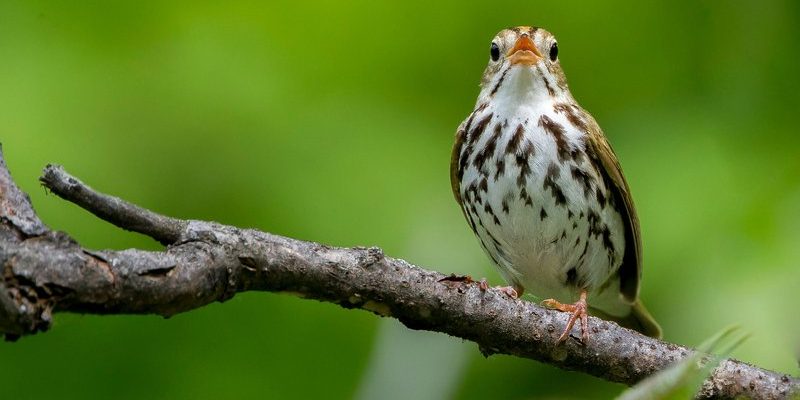
The Ovenbird is more than just a bird; it’s a captivating piece of nature that embodies the beauty of sound and the intricacies of life within our forests. Picture this: you’re wandering through a dense woodland, the rustling leaves creating a gentle symphony. Suddenly, a clear, flute-like song cuts through the air, drawing your attention. That enchanting melody likely belongs to the Ovenbird, a small but striking bird known for its unique nesting habits and beautiful vocalizations.
With its camouflaged plumage that blends seamlessly into the leaf litter, the Ovenbird can often go unnoticed. But once you learn about its fascinating behaviors and important role in the ecosystem, you’ll see this bird in a whole new light. Let’s dive deeper into the world of the Ovenbird, exploring everything from its habitat and diet to how it gets its intriguing name.
What is an Ovenbird?
The Ovenbird (Seiurus aurocapilla) is a small, ground-nesting songbird that belongs to the New World warbler family. Found primarily in North America, these birds prefer deciduous and mixed forests, especially those with dense underbrush. Ovenbirds are distinguished by their olive-brown coloration, a bold black stripe running through their eyes, and a distinct, rounded crown, which is often a bright orange hue.
Measuring around 5 to 6 inches in length and weighing roughly 0.5 to 0.6 ounces, Ovenbirds are relatively small when compared to other birds. Despite their small size, they have a big personality, especially when it comes to singing. Their call—a series of melodious notes often described as “teacher-teacher-teacher”—is a key identifier during the breeding season. This calling not only marks their territory but also attracts potential mates, making their vocal talents essential for survival.
Ovenbird Habitat
Ovenbirds thrive in a variety of habitats, but they are especially fond of mature forests that offer ample leaf litter and ground cover. These environments provide the necessary resources for both feeding and nesting. The typical Ovenbird habitat includes areas with dense understories where they can forage for insects and other small invertebrates. They are often found in regions ranging from the Eastern United States to parts of Canada, particularly during the spring and summer months.
Interestingly, Ovenbirds prefer to keep close to the ground, which makes their distinctive nesting behavior all the more remarkable. They create nests that resemble small ovens—thus the name—built on the forest floor, usually hidden under a canopy of leaves. This unique nesting strategy not only protects them from predators but also allows them to blend into their surroundings, a clever survival tactic that keeps them safe.
Ovenbird Diet
The diet of the Ovenbird is varied and primarily consists of insects, spiders, and other invertebrates, making it an insectivorous bird. During the warmer months, Ovenbirds can be seen foraging through the leaf litter for food, using their sharp senses to uncover hidden treasures. They are most active during the day, searching for caterpillars, beetles, and other small creatures that make up their diet.
In addition to insects, Ovenbirds will also eat seeds and berries when available, especially in the fall and winter months. This adaptability in food choice helps them survive during different seasons, ensuring they get the nutrients needed for energy and health. As a result, these birds play an essential role in controlling insect populations, making them valuable contributors to their ecosystems.
Unique Nesting Behavior
As mentioned earlier, the nesting habits of the Ovenbird are quite unique. Their nests are built on the ground and are made up of grass, twigs, and leaves, forming a dome-shaped structure. The entrance is strategically placed on the side, providing cover and protection for the eggs and chicks inside. This clever design is reminiscent of a small oven, hence the bird’s name.
A female Ovenbird typically lays around 3 to 5 eggs, which are speckled and blend in well with their surroundings. Incubation lasts about 12 to 14 days, during which the male often sings nearby to defend their territory and keep potential threats at bay. Once the eggs hatch, both parents work together to feed the chicks, bringing them a variety of insects to ensure healthy growth.
Ovenbird Migration
Like many birds, the Ovenbird migrates seasonally. During spring, they travel north to their breeding territories in North America, returning south for the winter months. Migration typically occurs at night, which can be quite a sight—hundreds of these small, agile birds traveling together across vast distances. This journey can cover thousands of miles, as they move from their summer breeding grounds in the northern forests to wintering locations in Central America and the southern United States.
During migration, Ovenbirds face numerous challenges, including changing weather conditions and potential predators. However, their innate navigational skills help them find safe paths to their destinations. This incredible endurance and resilience are a testament to the Ovenbird’s adaptability and survival instincts.
Conservation Status
Currently, the Ovenbird is classified as a species of “Least Concern” by the IUCN, which means they are not under immediate threat of extinction. However, habitat loss due to deforestation and urban development poses a significant risk to their populations. As more forests are cleared for agriculture or development, the natural environments these birds depend on for nesting and foraging are shrinking.
Conservation efforts are crucial to ensure that these charming birds continue to thrive. Protecting their habitats, supporting reforestation initiatives, and creating awareness about the importance of preserving natural ecosystems are vital steps in preserving Ovenbird populations. By fostering a love for these birds, we can work together to ensure they remain a part of our forests for generations to come.
Interesting Facts About the Ovenbird
| Common Name: | Ovenbird |
| Scientific Name: | Seiurus aurocapilla |
| Length: | 5 to 6 inches |
| Weight: | 0.5 to 0.6 ounces |
| Habitat: | Deciduous and mixed forests |
| Diet: | Insects and berries |
| Breeding Season: | April to August |
| Migration: | North in spring, south in fall |
Ovenbird Vocalizations
One of the most captivating aspects of the Ovenbird is its beautiful and distinctive song. As mentioned earlier, their call often sounds like “teacher-teacher-teacher,” a phrase that not only captures attention but also plays a crucial role in attracting mates and establishing territory. This melodious song is especially prominent during the breeding season when males are particularly vocal.
The Ovenbird’s song has a clear, flute-like quality, which makes it stand out among the chorus of forest sounds. Interestingly, their vocalizations vary slightly between regions, showcasing the Ovenbird’s ability to adapt and develop local dialects. It’s a fascinating reminder of how geographic isolation can influence bird songs, much like accents in human languages.
Ovenbird’s Role in the Ecosystem
The Ovenbird plays an important role in its ecosystem, primarily by helping to control insect populations. Their diet consists mainly of insects, which means they actively contribute to keeping those populations in check. This not only benefits the Ovenbird but also supports a healthy balance within their forest habitat.
Additionally, as Ovenbirds forage and move through the underbrush, they help disperse seeds. This behavior encourages plant growth and promotes biodiversity in their environment, ultimately supporting the entire ecosystem. Without these small but mighty birds, our forest ecosystems would be less vibrant and healthy.
The Ovenbird is a remarkable bird that captures the essence of forest life through its beautiful song and unique nesting habits. From its intriguing diet to its enchanting migration patterns, this small creature plays a vital role in its ecosystem. By understanding and appreciating the Ovenbird, we can help protect its natural habitat and ensure future generations can enjoy its melodic presence in our forests.
FAQ
What does an Ovenbird look like?
The Ovenbird has a distinctive appearance with an olive-brown coloration and a bold black stripe across its eyes. It also features a rounded crown that is a bright orange color. The combination of these colors and patterns helps it blend into its forest surroundings, making it important for camouflage against predators.
How long do Ovenbirds live?
In the wild, Ovenbirds typically have a lifespan of around 2 to 3 years. However, some individuals have been known to live longer under favorable conditions. Their life expectancy can be influenced by various factors such as predation, habitat quality, and availability of food resources.
Where can I find Ovenbirds?
Ovenbirds are primarily found in North American forests, particularly in deciduous and mixed woodlands. During the breeding season, they inhabit areas ranging from the Eastern United States to parts of Canada. In winter, they migrate to Central America and the southern United States.
Are Ovenbirds social birds?
Ovenbirds are generally solitary outside of the breeding season. During that time, males become more territorial, singing to defend their areas and attract mates. They may be seen in pairs during the breeding season, but outside of that, they prefer to forage alone.
What is the best time to see Ovenbirds?
The best time to observe Ovenbirds is during the breeding season, which typically runs from April to August. Early mornings and late afternoons are particularly active periods, as they sing to establish their territory and attract mates.
Do Ovenbirds migrate alone or in groups?
Ovenbirds primarily migrate alone or in small family groups. Their migration usually takes place at night, allowing them to travel long distances without the risk of predators during daylight hours. This behavior helps them navigate effectively to their wintering grounds.
What threats do Ovenbirds face?
The primary threats to Ovenbirds include habitat loss due to deforestation, urban development, and agricultural expansion. Additionally, they face risks from predators such as cats and other birds of prey. Conservation efforts are essential to protect their habitats and ensure their survival.
How can I help protect Ovenbirds?
You can help protect Ovenbirds by supporting conservation initiatives that focus on preserving forests and natural habitats. You can also promote awareness about the importance of these birds and their role in the ecosystem. Planting native plants in your garden can create a welcoming environment for all types of birds, including Ovenbirds.

